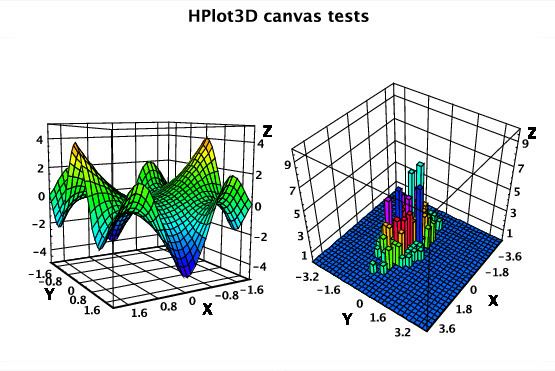Original author(s) Written in Java | Developer(s) Dr. Sergei V. Chekanov | |
 | ||
Initial release 2005 (2005) (initial name jHepWork) Stable release 1.6 / 12 January 2017; 40 days ago (2017-01-12) Repository github.com/chekanov/dmelt_jhplot | ||
DataMelt (or, in short, DMelt) a computation and visualization environment, is an interactive framework for scientific computation, data analysis and data visualization designed for scientists, engineers and students. DataMelt is multiplatform since it is written in Java, thus it runs on any operating system where the Java virtual machine can be installed.
Contents
- Overview
- Data analysis features
- Symbolic and numeric calculations
- Input and output
- History
- Supported platforms
- License terms
- Jython scripts
- Groovy scripts
- Publications
- References
The program is designed for interactive scientific plots in 2D and 3D and contains numerical scientific libraries implemented in Java for mathematical functions, random numbers, statistical analysis, curve fitting and other data mining algorithms. DataMelt uses high-level programming languages, such as Jython, Groovy, JRuby, but Java coding can also be used to call DataMelt numerical and graphical libraries.
DataMelt is an attempt to create a data-analysis environment using open-source packages with a coherent user interface and tools competitive to commercial programs. The idea behind the project is to incorporate open-source mathematical and numerical software packages with GUI-type user interfaces into a coherent program in which the main user interface is based on short-named Java/Python classes. This was required to build an analysis environment using Java scripting concept. A typical example will be shown below.
Scripts and Java code (in case of the Java programming) can be run either in a GUI editor of DataMelt or as batch programs. The graphical libraries of DataMelt can be used to create applets. All charts (or "Canvases") used for data representation can be embedded into Web browsers.
DataMelt can be used everywhere where an analysis of large numerical data volumes, data mining, statistical data analysis and mathematics are essential. The program can be used in natural sciences, engineering, modeling and analysis of financial markets. While the program falls into the category of open source software, it is not completely free for commercial usage (see below), no source code is available on the home page, and all documentation and even bug reporting requires "membership".
Overview
DataMelt has several features useful for data analysis:
Data-analysis features
The package supports several mathematical, data-analysis and data mining features:
Symbolic and numeric calculations
Symbolic calculations use GNU Octave scripting language. The following methods are available:
Input and output
DataMelt includes the native Java and Python methods for file input and outputs. In addition, it allows to write data in the following formats:
Data stored in external files can be viewed using browsers for convenient visualization.
History
DataMelt has its roots in particle physics where data mining is a primary task. It was created as jHepWork project in 2005 and it was initially written for data analysis for particle physics using the Java software concept for International Linear Collider project developed at SLAC. Later versions of jHepWork were modified for general public use (for scientists, engineers, students for educational purpose) since the International Linear Collider project has stalled. In 2013, jHepWork was renamed to DataMelt and become a general-purpose community-supported project. The main source of reference is the book "Scientific Data analysis using Jython Scripting and Java" and which discuss in depth data analysis methods using Java and Jython scripting. More recently, DataMelt was discussed in German Java SPEKTRUM journal.
The string "HEP" in the project name "jHepWork" abbreviates "High-Energy Physics". But due to a wide popularity outside this area of physics, it was renamed to SCaViS (Scientific Computation and Visualization Environment). This project existed for 3 years before it was renamed to DataMelt (or, in short, DMelt).
DataMelt is hosted by jWork.ORG portal
Supported platforms
DataMelt runs on Windows, Linux, Mac and the Android platforms. The package for the Android is called AWork.
License terms
The core source code of the numerical and graphical libraries is licensed by the GNU General Public License. The interactive development environment (IDE) used by DataMelt has some restrictions for commercial usage since language files, documentation files, examples, installer, code-assist databases, interactive help are licensed by the creative-common license. Full members of the DataMelt project have several benefits, such as: the license for a commercial usage, access to the source repository, an extended help system, a user script repository and an access to the complete documentation.
The commercial licenses cannot apply to source code that was imported or contributed to DataMelt from other authors.
Jython scripts
Here is an example of how to show 2D bar graphs by reading a CVS file downloaded from the World Bank web site.
The execution of this script plots a bar chart in a separate window. The image can be saved in a number of formats.
Here is another simple example which illustrates how to fill a 2D histogram and display it on a canvas. The script also creates a figure in the PDF format. This script illustrates how to glue and mix the native JAVA classes (from the package java.util) and DataMelt classes (the package jhplot) inside a script written using the Python syntax.
This script can be run either using DataMelt IDE or using a stand-alone Jython after specifying classpath to DataMelt libraries. The output is shown below:
Groovy scripts
The same example can also be coded using Groovy programming language which is supported by DataMelt.
Groovy is better integrated with Java and can be a factor three faster for long loops over primitives compared to Jython.
